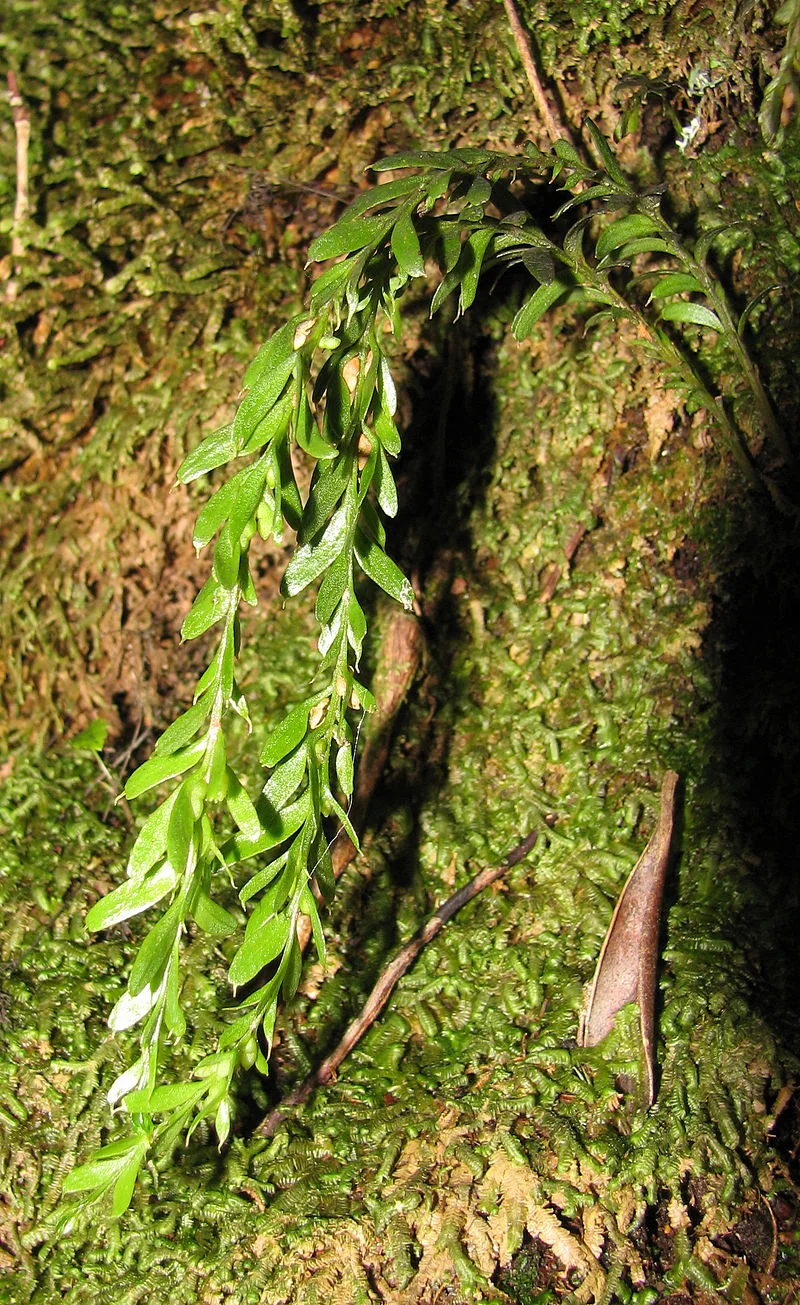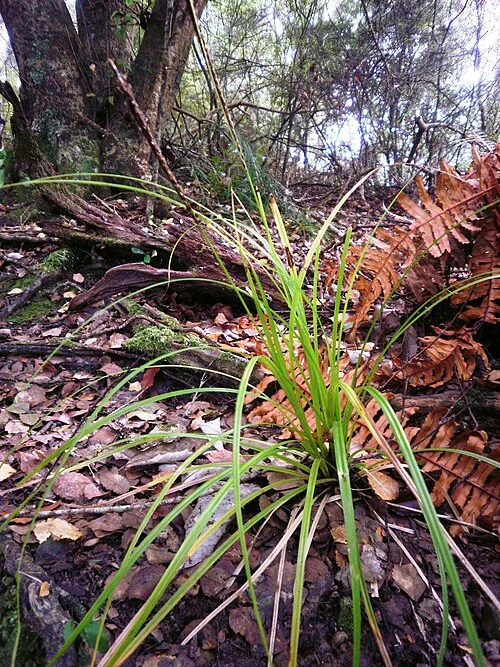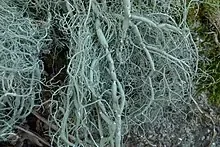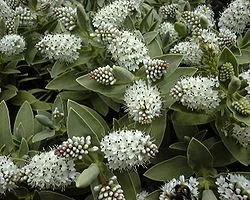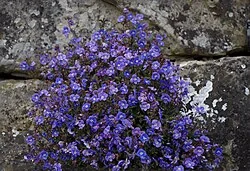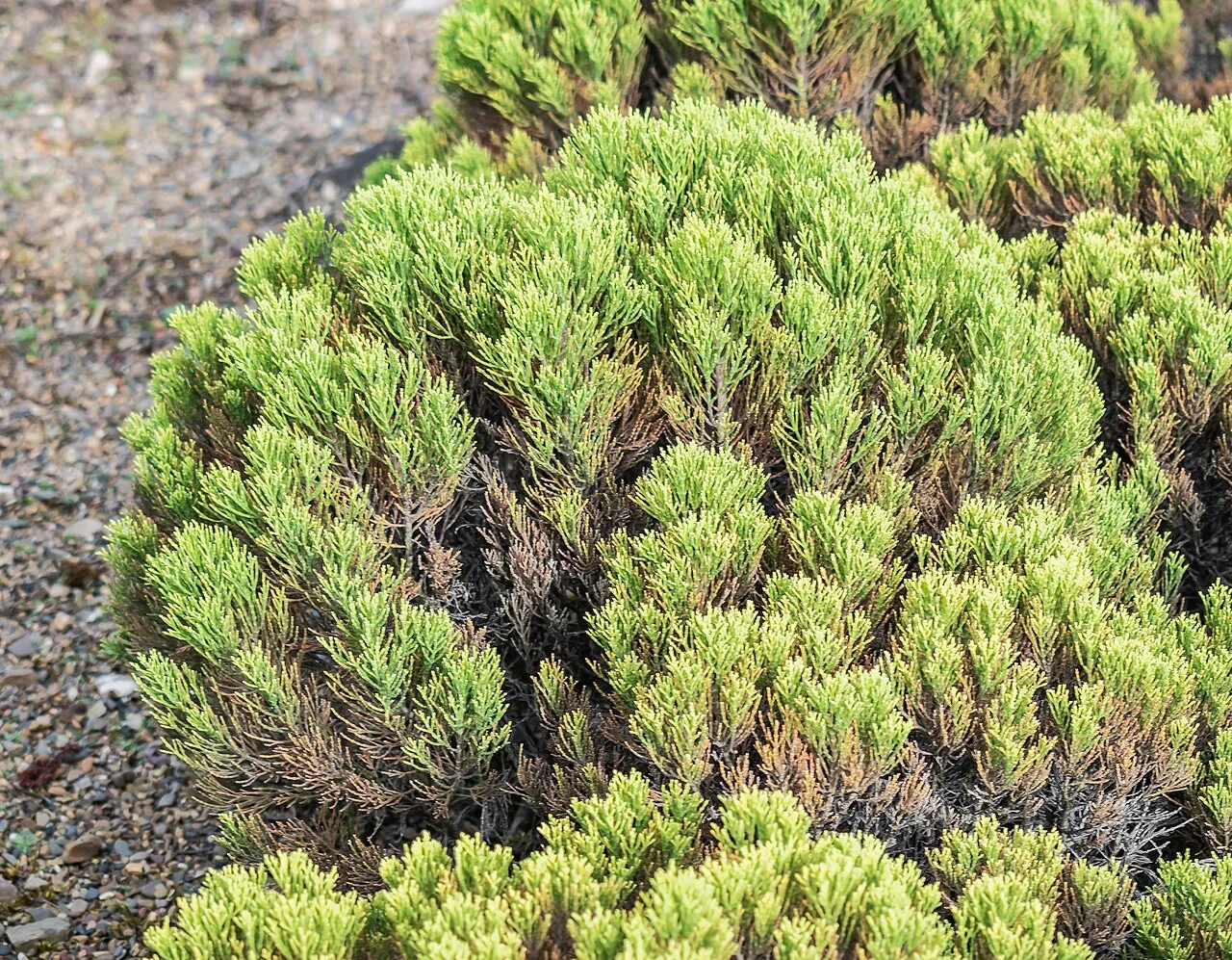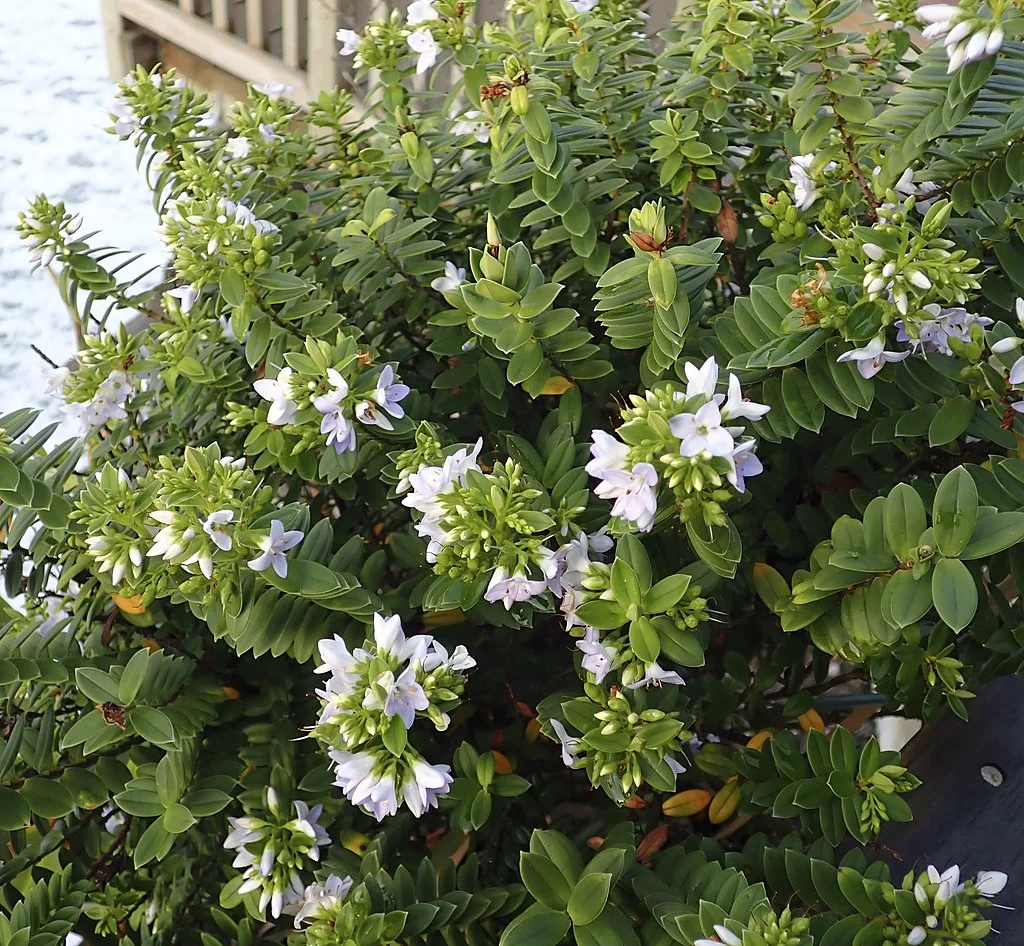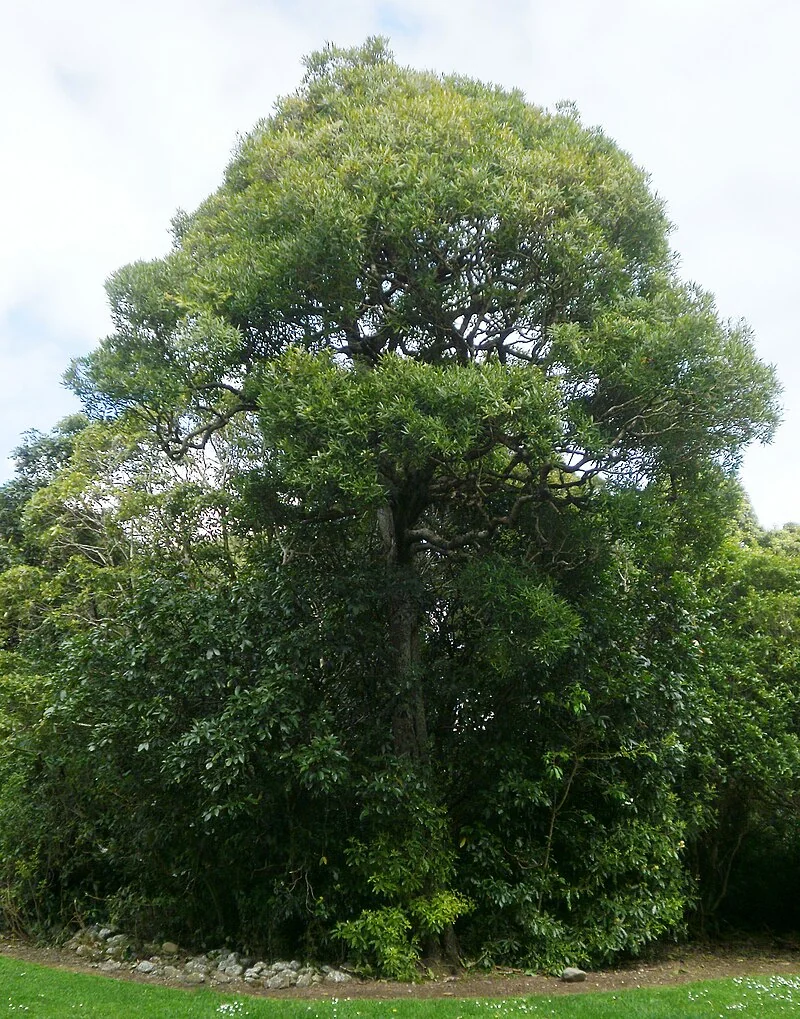
Bower Spinach
Tetragonia implexicoma
A sprawling coastal vine with fleshy, spinach-like leaves and small, edible, red to black fruits. Excellent salt and wind tolerance make it a reliable groundcover for coastal gardens among our coastal plants.

Plant Description
Botanical Features
Bower Spinach (Tetragonia implexicoma) is a perennial scrambling subshrub that can form dense, leafy patches up to 4 or 5 meters wide, often covering other plants and rocks. Its stems are long and trailing, often succulent and reddish when young, maturing to dark green or brown-black and becoming woody. The leaves are thick, warty, ovate or lanceolate to almost linear, often clustered, and semi-succulent, growing up to 4 cm long. They are bright green and can be rhombic to angular-ovate. Small, yellow, and strongly scented flowers, typically with 4 or 5 petals, bloom throughout the year, with a peak from late winter to mid-summer. The fruit are depressed-globular, fleshy berries, 5-8 mm long, which are pink to dark red and turn blackish when mature. The berries are eaten by birds and lizards. Bower Spinach is primarily found in coastal regions of New Zealand and southern Australia. It thrives in a variety of coastal habitats such as sand and shingle beaches, coastal woodlands, shrublands, grasslands, and on cliffs and stacks. It can also be found inland along tidal or brackish waterways, or on calcareous sandstone or limestone outcrops. It prefers well-draining, sandy soils and is tolerant of salt spray and wind.
Quick Facts
Vine Summary
| Scientific Name | Tetragonia implexicoma |
|---|---|
| Height | Up to 3 m (trailing) |
| Water Needs | Low to moderate; drought tolerant |
| Light | Full sun to partial shade |
| Spread | 1-2 m |
| Frost Tolerance | Low |
| Salt Tolerance | High; excellent for coastal conditions |
| Growth Rate | Moderate |
| Lifespan | Perennial |
Climate Best Suited to
Overview
Bower Spinach naturally thrives in New Zealand's coastal environments, demonstrating excellent tolerance to salt spray and strong coastal winds. It prefers temperate to subtropical climates with mild winters and is particularly well-adapted to areas with maritime influence.
Regional Suitability
| City | Climate Suitability |
|---|---|
| Auckland | Ideal |
| Wellington | Ideal |
| Christchurch | Good |
| Dunedin | Moderate |
| Whangārei | Ideal |
| Hamilton | Ideal |
| Tauranga | Ideal |
| Rotorua | Ideal |
| Gisborne | Ideal |
| New Plymouth | Ideal |
| Napier | Ideal |
| Whanganui | Ideal |
| Palmerston North | Ideal |
| Nelson | Ideal |
| Invercargill | Ideal |
Natural Habitat
Bower Spinach (Tetragonia implexicoma) is a perennial scrambling subshrub primarily found in coastal regions of New Zealand and southern Australia, as well as on many nearby island groups.
Key Habitats Include:
- Coastal Areas: It thrives on coastal dunes, sand and shingle beaches, cliffs, and foreshore scrub, demonstrating its exceptional tolerance to salt spray and dry conditions.
- Brackish Water and Tidal Waterways: It can extend inland along brackish water and tidal waterways.
- Coastal Woodland, Shrubland, and Grassland: It is also found in these habitats, showcasing its adaptability to various coastal plant communities.
- Inland (Occasionally): Occasionally, it can be found well inland in areas like farmland (growing in barberry hedges) or on calcareous sandstone or limestone outcrops in dense forest.
Preferred Conditions:
- Soil: It prefers well-draining, sandy soils, including coastal limestone and grey sandy soils.
- Light: It thrives in full sun to partial shade.
- Tolerance: It is highly tolerant of salt spray and wind, playing a crucial role in coastal ecosystems by binding loose sand.
The presence of Tetragonia implexicoma in these diverse coastal habitats underscores its ecological importance in contributing to the biodiversity and stability of New Zealand's natural coastal landscapes.
Plant Conservation
Bower spinach (Tetragonia implexicoma) is a vigorous coastal vine that is Not Threatened in New Zealand, though local declines occur where dune and cliff habitats are modified, browsed by stock, or overrun by invasive grasses and vines. Conservation efforts prioritise retaining continuous coastal scrub, controlling weeds, and using eco‑sourced plants to knit together eroding slopes. Its fleshy fruits feed birds that disperse seed, so protecting bird corridors enhances natural regeneration along shorelines.
Growing Requirements
Light Requirements
Prefers full sun but tolerates partial shade. Best growth and fruiting occurs in sunny positions.
Soil Requirements
Highly adaptable to various soil types including sandy, poor, and salt-affected soils. Excellent drainage essential.
Water Requirements
Drought tolerant once established. Requires minimal watering in most coastal situations.
Planting Guide
Tetragonia implexicoma, commonly known as Bower Spinach or Ice Plant, is a resilient perennial subshrub native to coastal regions of New Zealand and southern Australia. It is known for its sprawling, scrambling growth habit, forming dense leafy patches up to 0.5 meters (1ft 8in) high and spreading up to 2 meters (6ft) or more. It features bright green, semi-succulent leaves and produces small, strongly scented yellow flowers from late winter to mid-summer, followed by succulent red berries that turn black when mature.
1. Habitat and Growing Conditions:
- Soil: This plant is highly adaptable and thrives in light (sandy), medium (loamy), and heavy (clay) soils. It prefers well-draining, sandy soil and is commonly found in coastal dunes and on grey sandy soils.
- pH: It tolerates mildly acid, neutral, and mildly alkaline (basic) soils.
- Sunlight: Tetragonia implexicoma can grow in full sun to semi-shade (light woodland).
- Moisture: While it prefers moist soil, it is well-suited to dry conditions and exhibits strong drought tolerance, efficiently retaining water. It can also tolerate salt spray and strong coastal winds.
- Hardiness: It is hardy in USDA zones 8a to 11b.
2. Planting:
-
From Seed:
- Sow seeds just after the last spring frost, or in early to mid-spring in a greenhouse.
- Before planting, soak the thick, irregularly-shaped seeds for 12 hours in cold water or 3 hours in warm water to aid germination. Some sources suggest soaking in warm water for 24 hours. Another method involves soaking seeds in water for 4 days, changing the water daily.
- Plant seeds 0.2 to 0.4 inches (5 to 10 mm) deep.
- Space plants 6 to 12 inches (15 to 30 cm) apart, or at 1-meter intervals for dense ground cover.
- Seedlings typically emerge in 10 to 20 days. Germination can be variable and may increase in cooler weather.
- If collecting fresh seeds, it may be beneficial to store them at room temperature for a year before planting, as older seeds (1-2 years) often achieve higher germination rates.
-
From Cuttings:
- Tetragonia implexicoma is easily propagated from cuttings.
- Use cuttings from healthy, non-flowering stems, making clean cuts with a sharp tool.
- Plant in a well-draining medium, such as peat and perlite, keeping it moist.
- Consider using rooting hormone.
- Slowly acclimatize rooted plants to outdoor conditions before transplanting.
3. Care:
- Watering: It requires minimal watering, typically every 2-3 weeks, especially during dry periods. Avoid overwatering.
- Fertilizing: Use balanced fertilizers for general growth and high-nitrogen fertilizers for leaf greenness. Fertilize bi-monthly during growing seasons, adjusting amounts for growth stages, and use diluted solutions to prevent fertilizer burn.
- Pruning: Prune in early to late winter to manage size, promote fresh growth, and enhance its shape and density. Remove dead or overgrown stems with clean cuts. Regular pruning and harvesting of leaves can also help maintain the plant's form and vigor.
4. Uses:
- Groundcover and Erosion Control: Its sprawling habit makes it an excellent groundcover, especially in coastal areas, and it is invaluable for soil stabilization and erosion control.
- Edible: The leaves and berries are edible. Leaves can be eaten raw or cooked like spinach, and have a slightly salty taste. Like spinach, it contains oxalates, so blanching the leaves in hot water for one minute and then rinsing in cold water before cooking is recommended to remove medium to low levels of oxalates. The berries are also edible and were traditionally used as a source of red dye.
- Wildlife: Its flowers provide nectar for pollinators, and its berries are consumed by birds and possums. Its growth habit also offers shelter for various wildlife.
Ecological Role
Coastal Groundcover Uses
Bower spinach (Tetragonia implexicoma) sprawls over dunes and coastal rock, binding loose sand and creating cool refuges for invertebrates and lizards. Fleshy fruits are taken by birds, aiding dispersal along the coast.
Uses and Significance
Culinary Uses
- Leaves can be eaten as spinach substitute
- Small fruits are edible and nutritious
- Excellent source of vitamins and minerals
Garden Uses
- Outstanding coastal groundcover
- Erosion control on slopes and dunes
- Low-maintenance landscaping option
Landscaping Ideas
Coastal Groundcover
Use bower spinach to knit together sandy banks and low walls near the sea. Excellent for spilling over rock edges and stabilising dunes with other salt-tolerant natives.
Seasonal Care
Bower Spinach (Tetragonia implexicoma) is a low-maintenance, sprawling coastal vine that can provide edible leaves for much of the year. Its care focuses on mimicking its natural coastal habitat, with an emphasis on good drainage and protection from severe frost.
Spring
- Active Growth: Spring is an active growth period for Bower Spinach. New growth emerges, and the plant begins to spread.
- Planting: This is an ideal time to plant new specimens or sow seeds outdoors after the last frost date. Soaking seeds in cold water for 12 hours or warm water for 3 hours can improve germination.
- Harvesting: Leaves can be harvested from spring onwards.
Summer
- Flowering and Fruiting: Flowering typically occurs in summer, followed by the development of small, edible red to black fruits.
- Watering: Ensure ample water during dry spells to support growth and fruit development. While drought-tolerant, consistent moisture improves crop quality.
- Maintenance: Keep plants sheared to encourage continuous new growth and manage their spread.
Autumn
- Harvesting: Leaves can continue to be harvested.
- Frost Preparation: Bower Spinach is frost-tender. In regions with frost, it is often grown as an annual. If overwintering in warmer zones (USDA Zone 8 and warmer), ensure good drainage to prevent rot from winter wetness.
- Watering: Reduce watering frequency as temperatures cool and growth slows.
Winter
- Dormancy/Protection: In frost-free areas, it may continue to grow slowly. In areas with frost, plants can be kept alive in pots indoors with sufficient lighting.
- Watering: Reduce watering significantly during this cooler period, allowing the soil to dry out between waterings.
- Flowering: For Tetragonia implexicoma, yellow flowers can bloom from late winter to mid-spring.
Pruning
Techniques and Timing
Bower Spinach (Tetragonia implexicoma) is a vigorous, sprawling plant that generally requires minimal pruning. Pruning is primarily done to manage its size and spread, encourage bushier growth, or remove any unhealthy parts.
- Maintenance Pruning: Remove any dead, damaged, or diseased stems as needed. This helps maintain plant health and appearance.
- Size and Spread Control: Regular pruning can be beneficial to keep the plant within desired bounds, especially in smaller garden spaces. It responds well to being cut back.
- Encourage Bushiness: Lightly trim back overgrown or straggly stems to encourage a denser, more compact growth habit.
- Timing: Pruning can be done at any time of year as needed. For more significant shaping or size reduction, early spring or late winter is often a good time, allowing the plant to recover with new growth.
- Tools: Always use clean, sharp tools when pruning to prevent disease transmission.
How to Grow Bower Spinach
Bower Spinach is a sprawling coastal vine with succulent leaves and edible fruits. This hardy perennial forms a dense, spreading mat, making it an excellent choice for coastal gardens, rockeries, or as a drought-tolerant groundcover in sunny, well-drained areas. Endemic to New Zealand, it is typically found on coastal cliffs, sand dunes, and rocky shores. Its unique succulent foliage and vibrant flowers add a touch of exotic beauty to any landscape, showcasing the diversity of New Zealand's coastal flora. Understanding its propagation methods is key to successfully growing this delightful species.
From Seed
Seed propagation is the most reliable and straightforward method for establishing new Bower Spinach plants. This species produces abundant seed that germinates readily when conditions are right. Collect ripe berries in late summer to autumn when they turn red or dark purple-black. Extract seeds by removing the fleshy pulp and thoroughly washing them in clean water. Soak seeds overnight in warm water to improve germination rates and break dormancy. Sow seeds on a porous, well-draining seed-raising mix, covering to the depth of the seed width (approximately 2-3mm). Place containers in a warm, semi-shaded position with temperatures between 15-25°C. Keep the growing medium consistently damp but not waterlogged. Germination typically occurs within 14-28 days under optimal conditions. Transplant seedlings when they develop their second set of true leaves.
From Cuttings
Vegetative propagation through cuttings is extremely successful with Bower Spinach and allows for rapid establishment of new plants with identical characteristics to the parent. Select healthy, non-flowering stems approximately 10-15cm long from vigorous growth tips. Remove lower leaves, leaving 3-4 pairs at the tip. Allow cuttings to callus for 24-48 hours in a shaded, well-ventilated location. Insert cuttings into a free-draining propagation mix containing equal parts sand and organic matter. Water gently and maintain consistent moisture without waterlogging. Place in bright, indirect light with protection from strong sun. Roots typically develop within 2-4 weeks in temperatures above 18°C. Harden off gradually before transplanting to final positions.
From Rooted Pieces
Established plants naturally produce rooted runners that can be carefully separated to create new plants. This method is particularly effective for expanding existing plantings. Identify naturally rooted sections along trailing stems, usually at leaf nodes. Carefully lift rooted portions using a fork or spade to minimize root disturbance. Ensure each division has both healthy roots and above-ground growth. Plant immediately in prepared soil at the same depth as the original plant. Water thoroughly and provide temporary shade for the first week. Monitor regularly and maintain soil moisture until plants are actively growing.
Pests and Diseases
Generally robust in coastal sites. Young plants can be nibbled by slugs and snails; protect during establishment. Soft tips may attract aphids - pinch out and encourage airflow. Avoid waterlogged soils to prevent rot.
Cultural Significance
Tetragonia implexicoma, commonly known as Bower Spinach, holds cultural significance primarily as a traditional food source and for its practical uses. Historically, it was a significant food source for the Tasmanian Aboriginal people, who consumed its berries as a sweet snack or addition to meals. Early settlers also utilized the plant, cooking its succulent leaves like spinach. The leaves are noted for being a rich source of Vitamin C. Beyond its nutritional value, the berries of Tetragonia implexicoma, which ripen to a dark, almost black color, were valued for producing a red dye. Ecologically, the plant is recognized by Indigenous communities, such as the Wathaurung Aboriginal Corporation, as an important site stabilizer. More recently, it has been planted on Phillip Island as a fire retardant plant, highlighting its role in environmental management. The berries also serve as a food source for local wildlife, including birds and lizards.
Bonus Tip
Train bower spinach over low walls or rocks and pinch the tips in spring to encourage a denser mat. Avoid heavy feeding; lean soils keep growth compact and salt-hardy.
